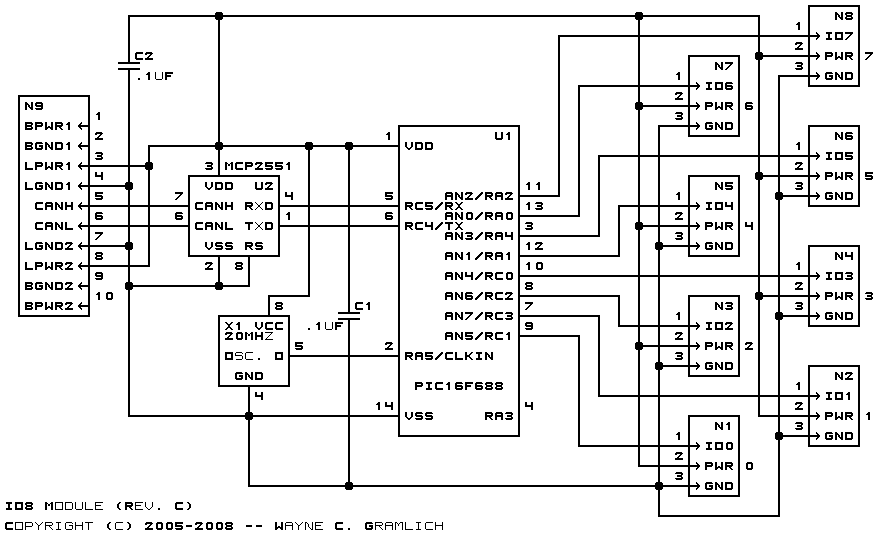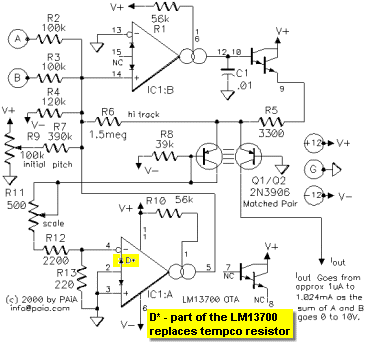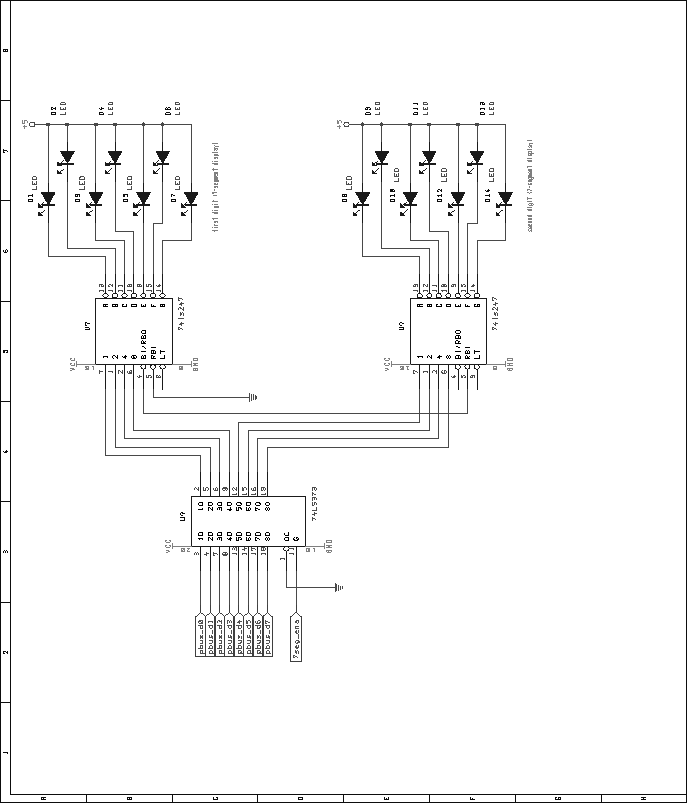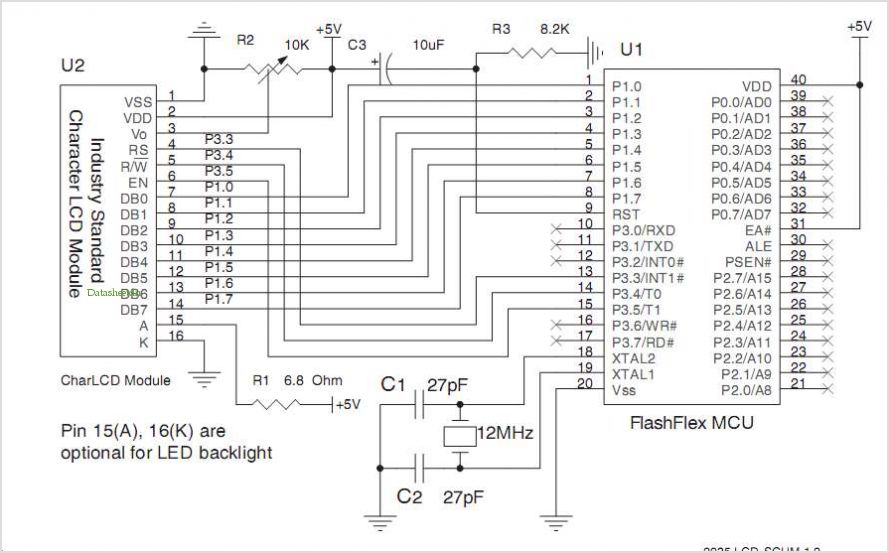
IO8 Module

The bus is connected to the 2G-5 shrouded connector N9. The two CAN bus signals are routed to the PCP2551 CAN bus transceiver U2. The output from U2 is directed to the UART transmit and receive signals on the PIC16F688 microcontroller U1. Eight pins of U1 are connected to a 1x3 polarized 1" male header. Each pin is linked to one of the analog inputs on U1. A half-size crystal oscillator (X1) is employed to provide the reference 20MHz signal. A resonator could not be utilized as it requires pins 2 and 3 of U1, with pin 3 designated for an analog input (AN3).
The circuit integrates a CAN bus communication system, utilizing the PCP2551 CAN bus transceiver (U2) to facilitate data transmission over the CAN protocol. The connection to the 2G-5 shrouded connector (N9) allows for a robust interface with external devices or systems, ensuring reliable signal integrity. The CAN bus signals are processed by the PCP2551, which converts the differential CAN signals into a format suitable for the PIC16F688 microcontroller (U1).
The PIC16F688 microcontroller serves as the central processing unit, handling both the reception and transmission of data via its UART interface. The UART signals are critical for serial communication, enabling the microcontroller to interact with other components or systems effectively. The microcontroller is interfaced with external components through a 1x3 polarized male header, which provides a convenient means for connecting additional circuitry or sensors. Each pin of this header corresponds to one of the analog inputs on the microcontroller, allowing for versatile input handling.
A half-size crystal oscillator (X1) is included in the design to provide a stable 20MHz clock signal, which is essential for the microcontroller's operation. The decision against using a resonator was made due to pin limitations; specifically, pins 2 and 3 of U1 are required for resonator connection, while pin 3 is allocated for an analog input (AN3). This careful selection of components ensures that the circuit functions optimally while adhering to the design constraints imposed by the microcontroller's pin configuration. Overall, this circuit demonstrates a well-thought-out approach to integrating CAN bus communication with a microcontroller, emphasizing reliability and functionality.The bus is connected to the 2G—5 shrouded conenctor N9. The two CAN bus signals are fed into the PCP2551 CAN bus transceiver U2. The output of U2 is fed to the UART transmit and receive signals on the PIC16F688 microcontroller U1. 8-pins of the U1 are connected to 1×3; polarized. 1" male headers. Each pin is connected to one of the anlog inpu ts on U1. A half size crystal oscillator (X1) is used to provide the reference 20MHz signal. A resonator could not be used since it requires pins 2 and 3 of U1, and pin 3 is needed for a analog input (AN3). 🔗 External reference
The circuit integrates a CAN bus communication system, utilizing the PCP2551 CAN bus transceiver (U2) to facilitate data transmission over the CAN protocol. The connection to the 2G-5 shrouded connector (N9) allows for a robust interface with external devices or systems, ensuring reliable signal integrity. The CAN bus signals are processed by the PCP2551, which converts the differential CAN signals into a format suitable for the PIC16F688 microcontroller (U1).
The PIC16F688 microcontroller serves as the central processing unit, handling both the reception and transmission of data via its UART interface. The UART signals are critical for serial communication, enabling the microcontroller to interact with other components or systems effectively. The microcontroller is interfaced with external components through a 1x3 polarized male header, which provides a convenient means for connecting additional circuitry or sensors. Each pin of this header corresponds to one of the analog inputs on the microcontroller, allowing for versatile input handling.
A half-size crystal oscillator (X1) is included in the design to provide a stable 20MHz clock signal, which is essential for the microcontroller's operation. The decision against using a resonator was made due to pin limitations; specifically, pins 2 and 3 of U1 are required for resonator connection, while pin 3 is allocated for an analog input (AN3). This careful selection of components ensures that the circuit functions optimally while adhering to the design constraints imposed by the microcontroller's pin configuration. Overall, this circuit demonstrates a well-thought-out approach to integrating CAN bus communication with a microcontroller, emphasizing reliability and functionality.The bus is connected to the 2G—5 shrouded conenctor N9. The two CAN bus signals are fed into the PCP2551 CAN bus transceiver U2. The output of U2 is fed to the UART transmit and receive signals on the PIC16F688 microcontroller U1. 8-pins of the U1 are connected to 1×3; polarized. 1" male headers. Each pin is connected to one of the anlog inpu ts on U1. A half size crystal oscillator (X1) is used to provide the reference 20MHz signal. A resonator could not be used since it requires pins 2 and 3 of U1, and pin 3 is needed for a analog input (AN3). 🔗 External reference




.jpg)
